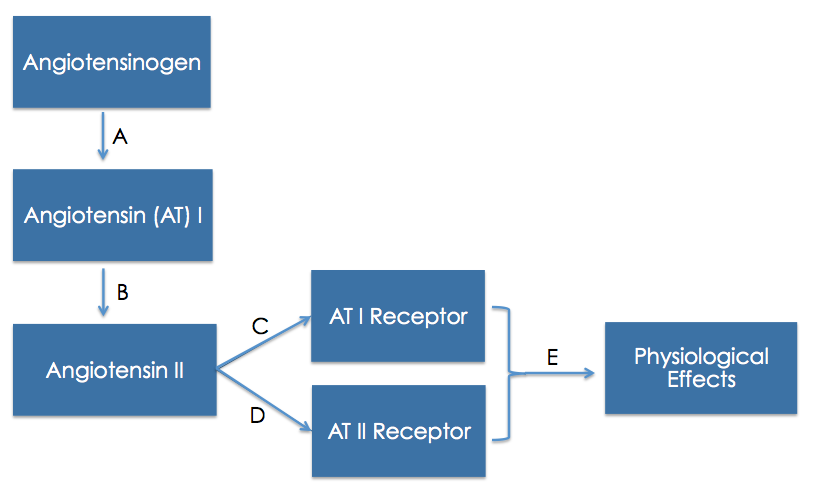WBR0735: Difference between revisions
Jump to navigation
Jump to search
Rim Halaby (talk | contribs) No edit summary |
Rim Halaby (talk | contribs) No edit summary |
||
| Line 27: | Line 27: | ||
|AnswerBExp=ACE is the enzyme that converts angiotensin I to angiotensin II. ACE-inhibitors act at this level. | |AnswerBExp=ACE is the enzyme that converts angiotensin I to angiotensin II. ACE-inhibitors act at this level. | ||
|AnswerC=C | |AnswerC=C | ||
|AnswerCExp=ACE-I | |AnswerCExp=ACE-I does not act at the level of the AT I receptor. | ||
|AnswerD=D | |AnswerD=D | ||
|AnswerDExp=Angiotensin II receptor blockers (ARB) act at this level of the pathway. | |AnswerDExp=Angiotensin II receptor blockers (ARB) act at this level of the pathway. | ||
Revision as of 23:27, 23 October 2013
| Author | [[PageAuthor::Rim Halaby, M.D. [1]]] |
|---|---|
| Exam Type | ExamType::USMLE Step 1 |
| Main Category | MainCategory::Pharmacology, MainCategory::Physiology |
| Sub Category | |
| Prompt | [[Prompt::A 52 year old male patient presents to the physician's office complaining of headache and blurry vision. His past medical history is only significant for dyslipidemia. He states that his blood pressure has been elevated on several previous occasions, but he has not been receiving any anti-hypertensive medication. Currently, he only takes rosuvastatin. He has no reported allergies. His vital signs show a temperature of 36.8 degrees C (98.24 degrees F), a heart rate of 72 bpm, and a blood pressure measuring 158/92 mmHg. The physician decides to start the patient on a medication that also inhibits the breakdown of bradykinin. Based on the image below, at which level of the renin-angiotensin pathway does the prescribed medication act? |
| Answer A | AnswerA::A |
| Answer A Explanation | AnswerAExp::Renin is the enzyme that converts angiotensinogen to angiotensin I. Renin inhibitors act at this level. |
| Answer B | AnswerB::B |
| Answer B Explanation | AnswerBExp::ACE is the enzyme that converts angiotensin I to angiotensin II. ACE-inhibitors act at this level. |
| Answer C | AnswerC::C |
| Answer C Explanation | AnswerCExp::ACE-I does not act at the level of the AT I receptor. |
| Answer D | AnswerD::D |
| Answer D Explanation | AnswerDExp::Angiotensin II receptor blockers (ARB) act at this level of the pathway. |
| Answer E | AnswerE::E |
| Answer E Explanation | AnswerEExp::ACE-I does not act at this level of the pathway. |
| Right Answer | RightAnswer::B |
| Explanation | [[Explanation::The prescribed medication to treat the patient's hypertension is most likely an angiotensin-converting enzyme (ACE) inhibitor. It is indicated for the management of hypertension and has compelling indications in specific cases such as the diabetic nephropathy due to its role in reducing proteinuria, which might by itself be injurious to the kidneys, and in left ventricular hypertrophy due to its role in preventing ventricular remodeling.
Classical side effects of ACE-I are angioedema, cough, and hyperkalemia. Cough is caused by the action of ACE-I in inhibiting bradykinin breakdown, leading to its local accumulation with activation of inflammatory peptides and release of histamine. Educational Objective: A classical side effect of ACE-I is dry cough. ACE-inhibitors act by preventing the production of Reference: Karlberg BE. Cough and inhibition of the renin-angiotensin system. J Hypertens Suppl. 1993; 11(3):S49-S52. |
| Approved | Approved::No |
| Keyword | WBRKeyword::angiotensin, WBRKeyword::angiotensinogen, WBRKeyword::receptor, WBRKeyword::blocker, WBRKeyword::converting, WBRKeyword::enzyme, WBRKeyword::ACE, WBRKeyword::inhibitor, WBRKeyword::ACE inhibitor, WBRKeyword::cough, WBRKeyword::bradykinin, WBRKeyword::side, WBRKeyword::effect |
| Linked Question | Linked:: |
| Order in Linked Questions | LinkedOrder:: |
